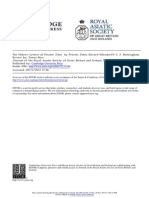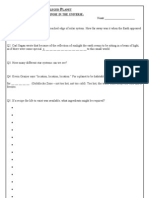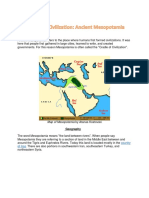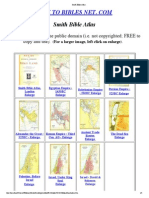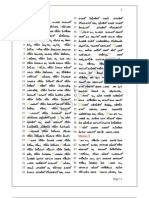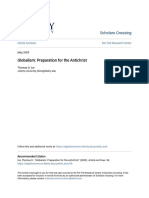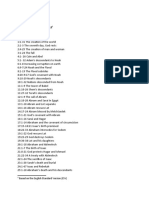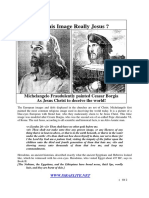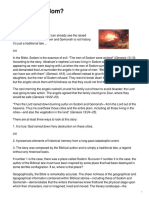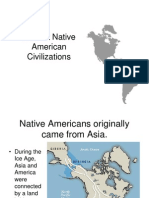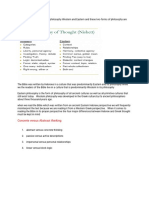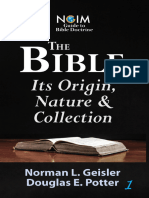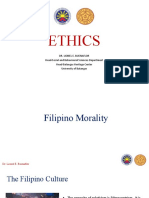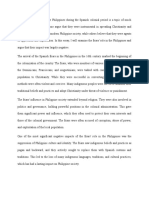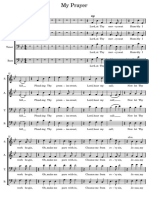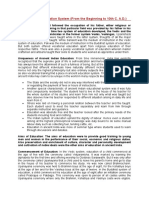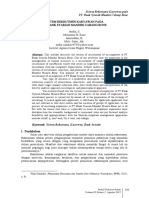0 ratings0% found this document useful (0 votes)
147 viewsHeb-Xn-Bibles Chart
This document provides a comparative chart that outlines the differences between the books included in the Jewish Tanakh/Hebrew Bible, Orthodox Christian Old Testament, Catholic Christian Old Testament, and Protestant Christian Old Testament. While there is some overlap between the collections, they differ in terms of the total number of books, arrangement of books into categories like Law, Prophets, and Writings, ordering of books within categories, and individual book titles. The Jewish Tanakh contains 24 books, while the Catholic Old Testament contains 46 books, recognizing additional deuterocanonical books not included in the Protestant 39-book Old Testament.
Uploaded by
Jhada BainCopyright
© © All Rights Reserved
Available Formats
Download as PDF, TXT or read online on Scribd
0 ratings0% found this document useful (0 votes)
147 viewsHeb-Xn-Bibles Chart
This document provides a comparative chart that outlines the differences between the books included in the Jewish Tanakh/Hebrew Bible, Orthodox Christian Old Testament, Catholic Christian Old Testament, and Protestant Christian Old Testament. While there is some overlap between the collections, they differ in terms of the total number of books, arrangement of books into categories like Law, Prophets, and Writings, ordering of books within categories, and individual book titles. The Jewish Tanakh contains 24 books, while the Catholic Old Testament contains 46 books, recognizing additional deuterocanonical books not included in the Protestant 39-book Old Testament.
Uploaded by
Jhada BainCopyright
© © All Rights Reserved
Available Formats
Download as PDF, TXT or read online on Scribd
You are on page 1/ 2
Jewish and Christian Bibles: A Comparative Chart
HEBREW BIBLE Orthodox Christian OT Catholic Christian OT Protestant Christian OT
(a.k.a. TaNaK/Tanakh or Mikra) (based on longer LXX; various editions) (Alexandrian LXX, with 7 deutero-can. bks) (Cath. order, but 7 Apocrypha removed)
Torah / Books of Moses Pentateuch Pentateuch (Law) Law (Pentateuch)
1) Bereshit / Genesis 1) Genesis 1) Genesis 1) Genesis
2) Shemot / Exodus 2) Exodus 2) Exodus 2) Exodus
3) VaYikra / Leviticus 3) Leviticus 3) Leviticus 3) Leviticus
4) BaMidbar / Numbers 4) Numbers 4) Numbers 4) Numbers
5) Devarim / Deuteronomy 5) Deuteronomy 5) Deuteronomy 5) Deuteronomy
Nevi’im / Former Prophets Historical Books Historical Books Historical Books
6) Joshua 6) Joshua 6) Joshua 6) Joshua
7) Judges 7) Judges 7) Judges 7) Judges
8) Samuel (1&2) 8) Ruth 8) Ruth 8) Ruth
9) Kings (1&2) 9) 1 Kingdoms (= 1 Sam) 9) 1 Samuel 9) 1 Samuel
10) 2 Kingdoms (= 2 Sam) 10) 2 Samuel 10) 2 Samuel
11) 3 Kingdoms (= 1 Kings) 11) 1 Kings 11) 1 Kings
Nevi’im / Latter Prophets 12) 4 Kingdoms (= 2 Kings) 12) 2 Kings 12) 2 Kings
10) Isaiah
13) 1 Chronicles 13) 1 Chronicles 13) 1 Chronicles
11) Jeremiah
14) 2 Chronicles 14) 2 Chronicles 14) 2 Chronicles
12) Ezekiel
15) 1 Esdras
13) The Book of the Twelve:
16) 2 Esdras (= Ezra + Nehemiah) 15) Ezra 15) Ezra
Hosea, Joel,
17) Esther (longer version) 16) Nehemiah 16) Nehemiah
Amos, Obadiah,
18) JUDITH 17) TOBIT
Jonah, Micah,
19) TOBIT 18) JUDITH
Nahum, Habakkuk,
19) Esther (longer version) 17) Esther (shorter version)
Zephaniah, Haggai,
20) 1 MACCABEES 20) 1 MACCABEES
Zechariah, Malachi
21) 2 MACCABEES 21) 2 MACCABEES
22) 3 Maccabees
23) 4 Maccabees
Khetuvim / Writings Poetic Books Wisdom Books Wisdom Books
14) Psalms (150) 24) Psalms (151) 22) Job 18) Job
15) Proverbs 25) Odes (w/ Prayer of Manasseh) 23) Psalms (150) 19) Psalms (150)
16) Job 26) Proverbs 24) Proverbs 20) Proverbs
17) Song of Solomon 27) Ecclesiastes 25) Ecclesiastes 21) Ecclesiastes
18) Ruth 28) Song of Solomon 26) Song of Solomon 22) Song of Solomon
19) Lamentations 29) Job 27) WISDOM of Solomon
20) Ecclesiastes 30) WISDOM of Solomon 28) SIRACH, a.k.a. Ecclesiasticus
21) Esther (shorter version) 31) SIRACH, a.k.a. Ecclesiasticus
22) Daniel (12 chapters) 32) Psalms of Solomon
23) Ezra-Nehemiah
24) Chronicles (1&2)
. Prophets Prophets Prophets
33) Hosea 29) Isaiah 23) Isaiah
34) Amos 30) Jeremiah 24) Jeremiah
35) Micah 31) Lamentations 25) Lamentations
36) Joel 32) BARUCH (w/ LETTER of JER.)
37) Obadiah 33) Ezekiel 26) Ezekiel
38) Jonah 34) Daniel (14 chapters) 27) Daniel (12 chapters)
39) Nahum
40) Habakkuk 35) Hosea 28) Hosea
41) Zephaniah 36) Joel 29) Joel
42) Haggai 37) Amos 30) Amos
43) Zechariah 38) Obadiah 31) Obadiah
44) Malachi 39) Jonah 32) Jonah
40) Micah 33) Micah
45) Isaiah 41) Nahum 34) Nahum
46) Jeremiah 42) Habakkuk 35) Habakkuk
47) BARUCH 43) Zephaniah 36) Zephaniah
48) Lamentations 44) Haggai 37) Haggai
49) LETTER of JEREMIAH 45) Zechariah 38) Zechariah
50) Ezekiel 46) Malachi 39) Malachi
51) Daniel (2 extra chapters separate):
52) SUSANNA
53) BEL and the DRAGON
compiled by Fr. Felix Just, S.J. http://catholic-resources.org/Bible/
Jewish and Christian Bibles: A Comparative Chart
KEY to the Chart (on the other side):
• HB = Hebrew Bible (Jewish); LXX = Septuagint (2nd cent. BC Greek translation of the HB); OT = Old Testament (Christian).
• Books in CAPITALS are found in Eastern Orthodox and Roman Catholic Bibles, but not in most Jewish or Protestant Bibles.
• Books in Italics are also in the LXX and considered biblical by Orthodox Christians, but NOT by Jews or most Christians.
Although the New Testament contains the same twenty-seven books for almost all Christians, there are some major and important differences
between the Hebrew Bible (HB) used by Jews and different versions of the Old Testament (OT) used by various Christian churches:
• The foundational texts are different:
o Jewish Bibles are based on the HB.
o The OT section in most Christian Bibles is arranged according to the order of books in the “Septuagint” (LXX).
o However, the translations of individual OT books in Christian Bibles are now usually based on the texts of the HB.
• The total number of biblical books is different:
o Jews count 24, Protestants 39, Catholics 46, Orthodox Christians up to 53.
o Certain books of the HB are subdivided in the LXX; e.g., “The Twelve” minor prophets are considered one book in the HB, while the
LXX and Christian Bibles count these as twelve separate books.
o The LXX contains several more books not found in the HB; Orthodox and Catholic Christians regard these additional books as part of
the OT canon (calling them “Deuterocanonical Books”), while Jews and most Protestants do not (considering them the “Apocrypha”).
• The arrangement of the categories of books is different:
o E.g. “Latter Prophets” come before “Writings” in the HB, but all “Prophets” come after “Wisdom” literature in the Christian OT.
o The order of the “Prophets” is also different between the LXX and the Catholic and Protestant OT’s.
• The titles of some of the books are different:
o E.g. “Samuel” of the HB is split up into “1 Kingdoms” and “2 Kingdoms” in the LXX, which are renamed “1 Samuel” and “2 Samuel” in
most Christian Bibles.
• The categorization of some books is different:
o E.g. several books categorized as “Writings” in HB are placed among “Historical Books” or “Prophets” in LXX and Christian OT; the
displacements of Ruth and Esther, Ezra-Nehemiah and Chronicles (1&2), and Lamentations and Daniel are highlighted in the chart.
Ancient Jewish Scriptures:
• Hebrew Bible (HB) - A collection of 24 “books” (or large “scrolls”), traditionally called the Mikra in Hebrew (or Miqra, lit. “writings”), now
often referred to as the “TaNaK” or “Tanakh” (from the Hebrew names of its three main sections: Torah + Nevi’im + Khetuvim). It is closely
related, but not identical, to what Christians call the “Old Testament.” Most of the books in the HB were composed between the 10th and
6th centuries BCE, although they contain some older source materials. Most were originally written in Hebrew, but a few books (or parts of
them) were composed in Aramaic, a closely related ancient language. Throughout history, Jews have used these books as “scriptures,”
although many ancient Jews (esp. Greek-speaking Jews living outside of Palestine) had even larger collections of scriptures (some from
more recent times, some composed in Greek; see the LXX below). The official “canon” of the HB was not determined until around 90 AD,
when the leading Jewish rabbis of the time limited their biblical collection to 24 Hebrew (or partly Aramaic) writings that came from the 6th
century BCE or earlier. The HB is divided into the following three categories (with the second category frequently sub-divided in two):
o Torah – often translated “Law,” but more accurately meaning “Teaching” or “Instruction” in Hebrew. Strictly speaking, “Torah” refers
to the first five books of the HB (Genesis, Exodus, Leviticus, Numbers, Deuteronomy), considered the “core” of the Bible by all Jews;
they are sometimes also called the “Five Books of Moses” (due to the tradition that Moses himself wrote them). More broadly, the word
“Torah” is sometimes used to refer to the entire “Tanak.” Many Jews also distinguish between the “Written Torah” (the Bible) and the
“Oral Torah” (other instructions given to Moses on Mount Sinai, but not written down until the “rabbinic literature” of 3rd to 7th cent.).
o Nevi’im – meaning “Prophets”; subdivided in Jewish Bibles into the “Former Prophets” (Joshua, Judges, Samuel, Kings - which also
contain stories of early “prophets” like Elijah, Elisha, Samuel, Nathan, etc.), and the “Latter Prophets” (Isaiah, Jeremiah, Ezekiel, and
“The Twelve” Minor Prophets; note that Jews do not include the Book of Daniel among the “Prophets,” but in the following category).
o Ketuvim (or Khetuvim) – meaning “Writings”; this “miscellaneous” group includes the books of Psalms, Job, Proverbs, Song of
Solomon, and Ecclesiastes (called “Wisdom Literature” by Christians), the books of Ruth, Esther, Ezra, Nehemiah, and Chronicles
(considered “Historical Books” in Christian Bibles), and the books of Daniel and Lamentations (placed among the “Prophets” in
Christian Bibles).
• Septuagint (LXX) - A collection of up to 53 books of ancient Jewish Scriptures written in Greek, including translations of all 24 books of the
HB (Daniel, Esther, and Jeremiah are longer in the Greek versions than in the original Hebrew), as well as seven or more additional books
(the "Deuterocanonical Books") that are not found in the HB.
• Deuterocanonical Books / OT Apocrypha - seven (or more) books that are in the LXX but not in the HB (Tobit, Judith, 1 & 2 Maccabees,
Wisdom, Ecclesiasticus, Baruch"), as well as some additions to the books of Esther and Daniel (longer in LXX than in HB). These texts are
considered biblical by Orthodox and Catholic Christians, but not by Jews and most Protestant Christians today.
• Summary: LXX = Ancient Greek translation of HB books + the "Apocrypha" or "Deuterocanonical Books."
compiled by Fr. Felix Just, S.J. http://catholic-resources.org/Bible/
You might also like
- Hourglass Workout Program by Luisagiuliet 276% (21)Hourglass Workout Program by Luisagiuliet 251 pages
- Read People Like A Book by Patrick King-Edited57% (80)Read People Like A Book by Patrick King-Edited12 pages
- Livingood, Blake - Livingood Daily Your 21-Day Guide To Experience Real Health77% (13)Livingood, Blake - Livingood Daily Your 21-Day Guide To Experience Real Health260 pages
- Donald Trump & Jeffrey Epstein Rape Lawsuit and Affidavits83% (1016)Donald Trump & Jeffrey Epstein Rape Lawsuit and Affidavits13 pages
- The 36 Questions That Lead To Love - The New York Times94% (34)The 36 Questions That Lead To Love - The New York Times3 pages
- The 36 Questions That Lead To Love - The New York Times95% (21)The 36 Questions That Lead To Love - The New York Times3 pages
- 14 Easiest & Hardest Muscles To Build (Ranked With Solutions)100% (8)14 Easiest & Hardest Muscles To Build (Ranked With Solutions)27 pages
- Jeffrey Epstein39s Little Black Book Unredacted PDF75% (12)Jeffrey Epstein39s Little Black Book Unredacted PDF95 pages
- (Contexts of Ancient and Medieval Anthropology (1)) Anna Usacheva (ed.)_ Jörg Ulrich (ed.)_ Siam Bhayro (ed.) - The Unity of Body and Soul in Patristic and Byzantine Thought-Brill Schoningh (2021)100% (1)(Contexts of Ancient and Medieval Anthropology (1)) Anna Usacheva (ed.)_ Jörg Ulrich (ed.)_ Siam Bhayro (ed.) - The Unity of Body and Soul in Patristic and Byzantine Thought-Brill Schoningh (2021)292 pages
- The 4 Hour Workweek, Expanded and Updated by Timothy Ferriss - Excerpt23% (954)The 4 Hour Workweek, Expanded and Updated by Timothy Ferriss - Excerpt38 pages
- T H e P e R I o D I C T A B L e o F T H e E L e M e N T SNo ratings yetT H e P e R I o D I C T A B L e o F T H e E L e M e N T S24 pages
- Back To Bibles Net. Com: Smith Bible AtlasNo ratings yetBack To Bibles Net. Com: Smith Bible Atlas2 pages
- Adams Et Al. Ch. 2 Area J 2004-2010 Megiddo V 2013 FULL-LibreNo ratings yetAdams Et Al. Ch. 2 Area J 2004-2010 Megiddo V 2013 FULL-Libre136 pages
- (1908) Decline & Fall of The Kingdom of JudahNo ratings yet(1908) Decline & Fall of The Kingdom of Judah252 pages
- Genesis Correctly Predicts Y Chromosome PatternNo ratings yetGenesis Correctly Predicts Y Chromosome Pattern9 pages
- From Jesus To Christianity - A History of The Early Church - 34No ratings yetFrom Jesus To Christianity - A History of The Early Church - 3434 pages
- Ingersoll - The Truth About The Holy BibleNo ratings yetIngersoll - The Truth About The Holy Bible41 pages
- MATIS-RED-LETTER-EDITION-CCB-56-pg-SAMPLE-1No ratings yetMATIS-RED-LETTER-EDITION-CCB-56-pg-SAMPLE-156 pages
- Globalism - Preparation For The Antichrist - Thomas D. IceNo ratings yetGlobalism - Preparation For The Antichrist - Thomas D. Ice5 pages
- Apocrypha in The 1611 KJV and The - Geneva - ArgumentNo ratings yetApocrypha in The 1611 KJV and The - Geneva - Argument3 pages
- Bible World History Timeline - 4004-3004BCNo ratings yetBible World History Timeline - 4004-3004BC1 page
- Outline of The Holy Bible Hebrew Bible Genesis: Based On The English Standard Version (ESV)100% (1)Outline of The Holy Bible Hebrew Bible Genesis: Based On The English Standard Version (ESV)2 pages
- Reed, Annette Yoshiko. ‘Abraham as Chaldean scientist and father of the Jews.. Josephus, Ant. 1.154-168, and the Greco-Roman discourse about astronomy-astrology’, Journal for the Study of Judaism, 35,2 (2004) 119-158No ratings yetReed, Annette Yoshiko. ‘Abraham as Chaldean scientist and father of the Jews.. Josephus, Ant. 1.154-168, and the Greco-Roman discourse about astronomy-astrology’, Journal for the Study of Judaism, 35,2 (2004) 119-15840 pages
- Download ebooks file The Genesis Apocryphon of Qumran Cave 1 1Q20 A Commentary 3rd Edition Joseph A. Fitzmyer all chapters100% (1)Download ebooks file The Genesis Apocryphon of Qumran Cave 1 1Q20 A Commentary 3rd Edition Joseph A. Fitzmyer all chapters73 pages
- Instant ebooks textbook Exploration in the World of the Ancients Revised Edition Discovery Exploration John S. Bowman download all chapters100% (6)Instant ebooks textbook Exploration in the World of the Ancients Revised Edition Discovery Exploration John S. Bowman download all chapters81 pages
- ? Is This Image Really Jesus ?: Michelangelo Fraudulently Painted Ceasar Borgia As Jesus Christ To Deceive The World!100% (1)? Is This Image Really Jesus ?: Michelangelo Fraudulently Painted Ceasar Borgia As Jesus Christ To Deceive The World!2 pages
- Do Roman Catholics KnOw Scientists Have Found The Tomb of Gilgamesh?100% (1)Do Roman Catholics KnOw Scientists Have Found The Tomb of Gilgamesh?4 pages
- Internal or Self Claims Evidences of The Inspiration of The BibleNo ratings yetInternal or Self Claims Evidences of The Inspiration of The Bible6 pages
- Levites and Priests in Biblical History and TraditionNo ratings yetLevites and Priests in Biblical History and Tradition268 pages
- Jehovah the First Godfather: An Agnostic's View of the Bible, God and ReligionFrom EverandJehovah the First Godfather: An Agnostic's View of the Bible, God and ReligionNo ratings yet
- Download A cabinet of ancient medical curiosities: strange tales and surprising facts from the healing arts of Greece and Rome 1st Edition J. C. Mckeown ebook All Chapters PDF100% (2)Download A cabinet of ancient medical curiosities: strange tales and surprising facts from the healing arts of Greece and Rome 1st Edition J. C. Mckeown ebook All Chapters PDF65 pages
- Calendar 101 - What in The World Is A Covenant Calendar (5 PGS) June 2020No ratings yetCalendar 101 - What in The World Is A Covenant Calendar (5 PGS) June 20205 pages
- Sources of Ancient Indian History and HistoriographyNo ratings yetSources of Ancient Indian History and Historiography8 pages
- Get 3D Radiology in Dentistry Diagnosis Pre Operative Planning Follow Up work1 free all chaptersNo ratings yetGet 3D Radiology in Dentistry Diagnosis Pre Operative Planning Follow Up work1 free all chapters28 pages
- The Complete Guide To Drow - The House of Azran100% (2)The Complete Guide To Drow - The House of Azran5 pages
- World Religions and Belief Systems Week 1No ratings yetWorld Religions and Belief Systems Week 110 pages
- Manajemen Personalia Dan Sumber Daya Manusia: Hani Handoko, (Yogyakarta: BPFE, 2013), H. 82No ratings yetManajemen Personalia Dan Sumber Daya Manusia: Hani Handoko, (Yogyakarta: BPFE, 2013), H. 8217 pages
- A Chinese Jesuit Catechism: Giulio Aleni's Four Character Classic 四字經文 Anthony E Clark pdf download100% (1)A Chinese Jesuit Catechism: Giulio Aleni's Four Character Classic 四字經文 Anthony E Clark pdf download55 pages

































